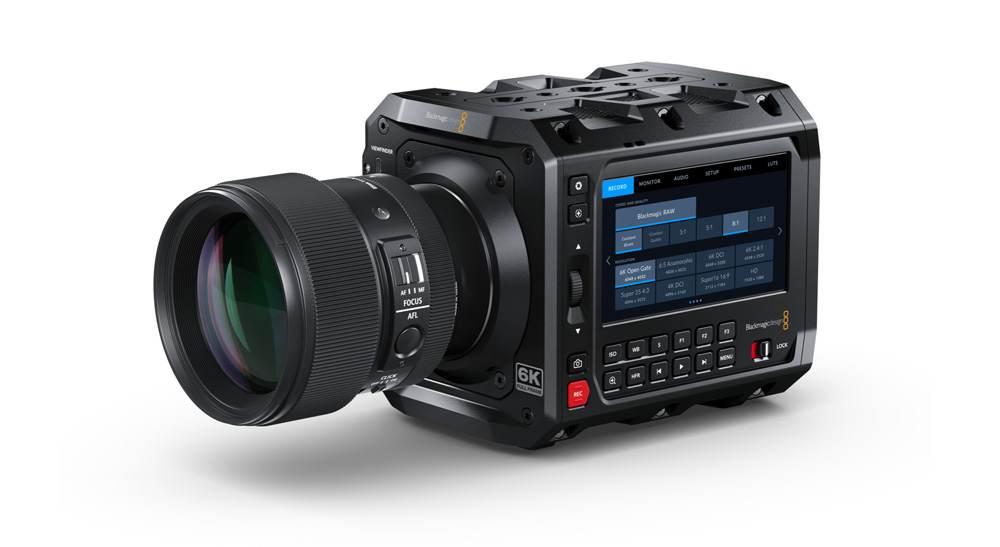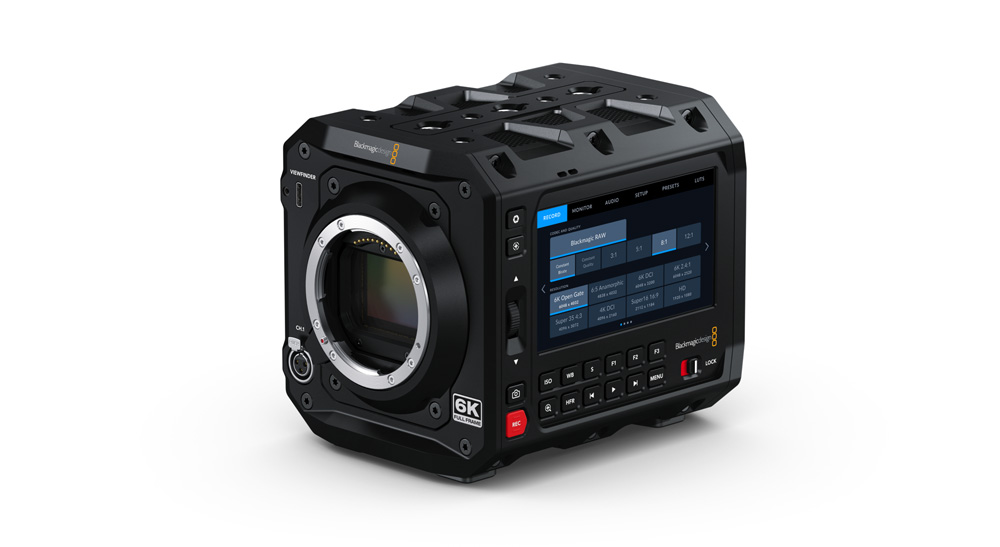Well, you asked for it, and Blackmagic has delivered. In their NAB 2024 preview, Grant Petty presented several new hardware and software additions to their lineup, one being the PYXIS 6K.
Blackmagic PYXIS Externals
While it’s not box-like in the sense of a RED KOMODO or Z-Cam, the ergonomics of the camera certainly slot it within the category group. It measures H 119mm x W 106mm x L 151mm and weighs 1.5kg. The compact frame of the device is crafted from aerospace aluminum that has been precision-machined using CNC techniques, ensuring it is both lightweight and exceptionally durable. It can be conveniently attached to various camera rigs including cranes, gimbals, and drones. Moreover, the Blackmagic PYXIS features multiple 1/4″ and 3/8″ threaded mounts on its top and bottom, as well as side plates that expand the possibilities for attaching accessories.
While everything sounds good so far, the built-in LCD on Blackmagic PYXIS somewhat follows the RED KOMODO in terms of ‘is this actually going to be practical?’ It’s a 4″ high-resolution HDR touchscreen with 1500 nits of brightness, so you can always see your shot or change settings, even in bright sunlight. However, it’s built into the side of the camera unit, not onto the back. While this may mirror camera controls from larger cinema cameras for assistant camera operator functionality, given the price point of the camera it looks like it’s aimed toward the indie and self-shooter, and as such the built-in screen on the side starts to mirror the impracticality of the KOMODO’s top screen. While the cameras are built to be compact, both require external monitors for any sense of practicality.

On the talk of practicality, let’s look at what body functions and operations are available with the PYXIS before jumping into the internals of the camera.
Blackmagic PYXIS features external function buttons such as ISO, WB, and even a scroll wheel for making quick adjustments to settings. There’s a row of 3 customizable function buttons, as well as function keys for high frame rate, focus, zoom, false colour, and more. The controls can even be locked to avoid accidentally changing settings during a shot or when the camera is out of reach on a rig. Unlike the KOMODO, the REC button is situated on the left-hand side near the front of the body, making it easily accessible.
Blackmagic PYXIS features a mini XLR input with 48 volts of phantom power, and there’s also a 3.5mm audio input for connecting video camera microphones, a built-in speaker for playback, and a 3.5mm headphone jack.
Additionally, around the body, we have:
- USB-C for Viewfinder – Connect Blackmagic URSA Cine EVF
- USB Expansion For mobile data or recording to external disks
- 12G-SDI Output For on set monitoring in HD and Ultra HD
- CFexpress Slots Dual slots for CFexpress media
- +12V DC Power – Use a mains power supply
- 1G Ethernet – Upload to Blackmagic Cloud or control camera
- REF/TC In – Reference or Timecode for syncing
Blackmagic PYXIS Internals
You receive a full-frame 36 x 24mm 6K sensor boasting a 13-stop wide dynamic range. It includes a built-in optical low pass filter (though no built-in ND filters) and records in both 12-bit Blackmagic RAW and extremely compact H.264 proxies. Similar to the 6K but distinct from the 6K PRO (yes, it’s a bit confusing), it features a large full-frame sensor with a native resolution of 6048 x 4032, nearly triple the size of a Super 35.

The expansive full-frame sensor in the Blackmagic PYXIS allows you to explore various film formats and aspect ratios without compromising quality! Utilizing the entire sensor area provides a unique open gate 3:2 image, which also offers flexibility to reframe your shots during post-production. Consistent with many recent Blackmagic devices, the camera features Dual Native ISO. The primary base ISO is set at 400, while the secondary higher base ISO stands at 3200, and it can be extended up to 25,600.

The Blackmagic PYXIS can capture up to 36 fps at 6048 x 4032 in a 3:2 open gate format, or 60 fps at 6048 x 2520 in a 2.4:1 aspect ratio, and 60 fps at 4096 x 2160 in 4K DCI. For higher frame rates, you can window the sensor to achieve up to 100 fps at 2112 x 1184 in Super 16. The camera also supports true anamorphic 6:5 at much higher resolutions than other cameras, recording in anamorphic 4.8K at 24 fps with dimensions of 4832 x 4032. Furthermore, it can shoot 120 fps in 1080HD. While speeds exceeding 60 fps post-4K might seem somewhat limited as of 2024, it’s important to consider the price: at £2910 (or £3094 for the PL mount), this camera offers substantial capabilities without all the high-end extras typically found at higher price points.
The Blackmagic PYXIS 6K comes in three versions, though the mounts are fixed and cannot be swapped. You have the option to select from L-Mount, PL, or Locking EF lens mounts.
Specs at Quick Glance
Shooting Resolutions
6048 x 4032 (Open Gate 3:2) up to 36 fps
4832 x 4032 (Anamorphic 6:5) up to 36 fps
6048 x 3200 (6K DCI 17:9) up to 48 fps
6048 x 2520 (6K 2.4:1) up to 60 fps
4096 x 3072 (Super 35 4:3) up to 50 fps
4096 x 2160 (4K DCI 17:9) up to 60 fps
2112 x 1184 (Super 16 16:9) up to 100 fps
1920 x 1080 (1080 HD 16:9) up to 120 fps
Dynamic Range
13 Stops
Dual Native ISO
400 and 3200
Frame Rates
Maximum sensor frame rate dependent on resolution and codec selected. Project frame rates of 23.98, 24, 25, 29.97, 30, 50, 59.94 and 60 fps supported.
Off-speed frame rates up to 60 fps in 6K 2.4:1 and 4K DCI 17:9, 100 fps in Super 16 16:9 and 120 fps in 1080HD.
Supported Codecs
Codecs
Blackmagic RAW Constant Bitrate 3:1
Blackmagic RAW Constant Bitrate 5:1
Blackmagic RAW Constant Bitrate 8:1
Blackmagic RAW Constant Bitrate 12:1
Blackmagic RAW Constant Quality Q0
Blackmagic RAW Constant Quality Q1
Blackmagic RAW Constant Quality Q3
Blackmagic RAW Constant Quality Q5
H.264 Proxy in 1920 x 1080, 8-bit 4:2:0
Storage Type
1 x CFexpress Type B
1 x high speed USB-C expansion port for external media.
Final Thoughts
While there appear to be a number of important functions missing from the PYXIS 6K—at least for me—it seems that this camera will help bridge the gap for users transitioning from the Pocket Cinema line to the Ursa line without having to spend upwards of £5,000. Hopefully, I’ll be able to get my hands on one to continue the cine-visual series featured on the UglyMcGregor YouTube channel.
All images via Blackmagic
For more on Blackmagic, check out these articles:
Blackmagic Pocket Cinema Camera 6k Pro Q&A
How Much Does It Cost To Get The Blackmagic Pocket 4K Operational?

